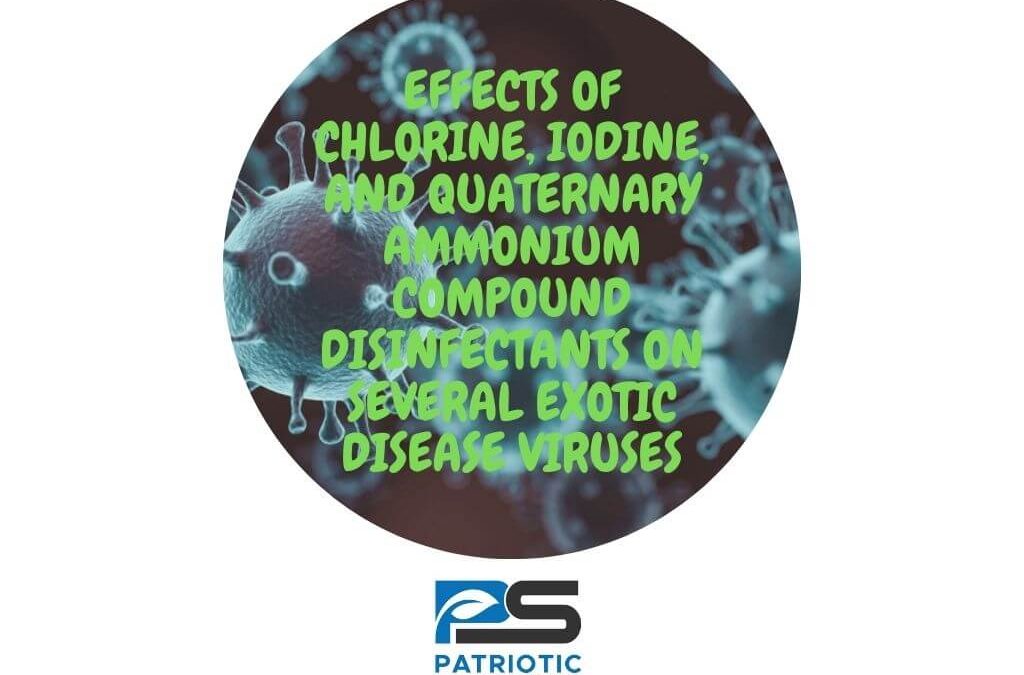Abstract
The effects of three representative disinfectants, chlorine (sodium hypochlorite), iodine (potassium tetraglicine triiodide), and quaternary ammonium compound (didecyldimethylammonium chloride), on several exotic disease viruses were examined. The viruses used were four enveloped viruses (vesicular stomatitis virus, African swine fever virus, equine viral arteritis virus, and porcine reproductive and respiratory syndrome virus) and two non-enveloped viruses (swine vesicular disease virus (SVDV) and African horse sickness virus (AHSV)). Chlorine was effective against all viruses except SVDV at concentrations of 0.03% to 0.0075%, and a dose response was observed. Iodine was very effective against all viruses at concentrations of 0.015% to 0.0075%, but a dose response was not observed. Quaternary ammonium compound was very effective in low concentration of 0.003% against four enveloped viruses and AHSV, but it was only effective against SVDV with 0.05% NaOH. Electron microscopic observation revealed the probable mechanism of each disinfectant. Chlorine caused complete degeneration of the viral particles and also destroyed the nucleic acid of the viruses. Iodine destroyed mainly the inner components including nucleic acid of the viruses. Quaternary ammonium compound induced detachment of the envelope of the enveloped viruses and formation of micelle in non-enveloped viruses. According to these results, chlorine and iodine disinfectants were quite effective against most of the viruses used at adequately high concentration. The effective concentration of quaternary ammonium compound was the lowest among the disinfectants examined.
OPINION/CONCLUSION:
Based on the information in the above article iodine solutions need to be considered. Iodine was very effective against all viruses at concentrations of 0.015% to 0.0075%. To better understand this the percentage needs to be converted to ppm (Parts Per Million). What was tested was an iodine solution that had a concentration of 15 ppm to 75 ppm. If an iodine solution of just 15 ppm to 75 ppm is effective, then how effective is an iodine solution with 75 ppm to 150 ppm.
Consider this information from the CDC, the article is iodopors Disinfectants in navigation on the left.
Published reports on the in vitro antimicrobial efficacy of iodophors demonstrate that iodophors are bactericidal, mycobactericidal, and virucidal but can require prolonged contact times to kill certain fungi and bacterial spores. Three brands of povidone-iodine solution have demonstrated more rapid kill (seconds to minutes) of S. aureus and M. chelonae at a 1:100 dilution than did the stock solution. The virucidal activity of 75–150 ppm available iodine was demonstrated against seven viruses. Other investigators have questioned the efficacy of iodophors against poliovirus in the presence of organic matter and rotavirus SA-11 in distilled or tap water. Manufacturers’ data demonstrate that commercial iodophors are not sporicidal, but they are tuberculocidal, fungicidal, virucidal, and bactericidal at their recommended use-dilution.
Therefore, a perplexing question. How effective is iodine in 300 ppm. Using lugols 5% or 2.2% can be very effective. Iodine as a disinfectant is extremely cost effective. Lugols iodine solution has been tested and research since it was created in 1829, a proven option in these pandemic times.







